Proud to say that danq.me is the newest site to be admitted into Kev Quirk‘s 512kb club. Let’s keep the web lean!
Tag: published on gemini
RSS Zero isn’t the path to RSS Joy
Feed overload is real
The week before last, Katie shared with me that article from last month, Who killed Google Reader? I’d read it before so I didn’t bother clicking through again, but we did end up chatting about RSS a bit1.

Katie “abandoned feeds a few years ago” because they were “regularly ending up with 200+ unread items that felt overwhelming”.
Conversely: I think that dropping your feed reader because there’s too much to read is… solving the wrong problem.

Dave Rupert last week wrote about his feed reader’s “unread” count having grown to a mammoth 2,000+ items, and his plan to reduce that.
I think that he, like Katie, might be looking at his reader in a different way than I do mine.

RSS is not email!
I’ve been in the position that Katie and David describe: of feeling overwhelmed by the sheer volume of unread items. And I know others have, too. So let me share something I’ve learned sooner:
There’s nothing special about reaching Inbox Zero in your feed reader.
It’s not noble nor enlightened to get to the bottom of your “unread” list.
Your 👏 feed 👏 reader 👏 is 👏 not 👏 an 👏 email 👏 client. 👏
The idea of Inbox Zero as applied to your email inbox is about productivity. Any message in your email might be something that requires urgent action, and you won’t know until you filter through and categorise .
But your RSS reader doesn’t (shouldn’t?) be there to add to your to-do list. Your RSS reader is a list of things you might like to read. In an ideal world, reaching “RSS Zero” would mean that you’ve seen everything on the Internet that you might enjoy. That’s not enlightened; that’s sad!

Use RSS for joy
My RSS reader is a place of joy, never of stress. I’ve tried to boil down the principles that makes it so, and here they are:
-
Zero is not the target.
The numbers are to inspire about how much there is “out there” for you, not to enumerate how much work need have to do. -
Group your feeds by importance.
Your feed reader probably lets you group (folder, tag…) your feeds, so you can easily check-in on what you care about and leave other feeds for a rainy day.2 This is good. -
Don’t read every article.
Your feed reader gives you the convenience of keeping content in one place, but you’re not obligated to read every single one. If something doesn’t interest you, mark it as read and move on. No judgement. -
Keep things for later.
Something you want to read, but not now? Find a way to “save for later” to get it out of your main feed so you. Don’t have to scroll past it every day! Star it or tag it3 or push it to your link-saving or note-taking app. I use a link shortener which then feeds back into my feed reader into a “for later” group! -
Let topical content expire.
Have topical/time-dependent feeds (general news media, some social media etc.)? Have reader “purge” unread articles after a time. I have my subscription to BBC News headlines expire after 5 days: if I’ve taken that long to read a headline, it might as well disappear.4 -
Use your feed reader deliberately.
You don’t need popup notifications (a new article’s probably already up to an hour stale by the time it hits your reader). We’re all already slaves to notifications! Visit your reader when it suits you. I start and end every day in mine; most days I hit it again a couple of other times. I don’t need a notification: there’s always new content. The reader keeps track of what I’ve not looked at. -
It’s not just about text.
Don’t limit your feed reader to just text. Podcasts are nothing more than RSS feeds with attached audio files; you can keep track in your reader if you like. Most video platforms let you subscribe to a feed of new videos on a channel or playlist basis, so you can e.g. get notified about YouTube channel updates without having to fight with The Algorithm. Features like XPath Scraping in FreshRSS let you subscribe to services that don’t even have feeds: to watch the listings of dogs on local shelter websites when you’re looking to adopt, for example. -
Do your reading in your reader.
Your reader respects your preferences: colour scheme, font size, article ordering, etc. It doesn’t nag you with newsletter signup popups, cookie notices, or ads. Make the most of that. Some RSS feeds try to disincentivise this by providing only summary content, but a good feed reader can work around this for you, fetching actual content in the background.5 -
Use offline time to catch up on your reading.
Some of the best readers support offline mode. I find this fantastic when I’m on an aeroplane, because I can catch up on all of the interesting articles I’d not had time to yet while grounded, and my reading will get synchronised when I touch down and disable flight mode. -
Make your reader work for you.
A feed reader is a tool that works for you. If it’s causing you pain, switch to a different tool6, or reconfigure the one you’ve got. And if the way you find joy from RSS is different from me, that’s fine: this is a personal tool, and we don’t have to have the same answer.
And if you’d like to put those tips in your RSS reader to digest later or at your own pace, you can: here’s an
RSS feed containing (only) these RSS tips!
Footnotes
1 You’d be forgiven for thinking that RSS was my favourite topic, given that so-far-this-year I’ve written about improving WordPress’s feeds, about mathematical quirks in FreshRSS, on using XPath scraping as an RSS alternative (twice), and the joy of getting notified when a vlog channel is ressurected (thanks to RSS). I swear I have other interests.
2 If your feed reader doesn’t support any kind of grouping, get a better reader.
3 If your feed reader doesn’t support any kind of marking/favouriting/tagging of articles, get a better reader.
4 If your feed reader doesn’t support customisable expiry times… well that’s not too unusual, but you might want to consider getting a better reader.
5 FreshRSS calls the feature that fetches actual post content from the resulting page “Article CSS selector on original website”, which is a bit of a mouthful, but you can see what it’s doing. If your feed reader doesn’t support fetching full content… well, it’s probably not that big a deal, but it’s a good nice-to-have if you’re shopping around for a reader, in my opinion.
6 There’s so much choice in feed readers, and migrating between them is (usually) very easy, so everybody can find the best choice for them. Feedly, Inoreader, and The Old Reader are popular, free, and easy-to-use if you’re looking to get started. I prefer a selfhosted tool so I use the amazing FreshRSS (having migrated from Tiny Tiny RSS). Here’s some more tips on getting started. You might prefer a desktop or mobile tool, or even something exotic: part of the beauty of RSS feeds is they’re open and interoperable, so if for example you love using Slack, you can use Slack to push feed updates to you and get almost all the features you need to do everything in my list, including grouping (using channels) and saving for later (using Slackbot/”remind me about this”). Slack’s a perfectly acceptable feed reader for some people!
Not the Isle of Man
This week, Ruth and I didn’t go the Isle of Man.

It’s (approximately) our 0x10th anniversary1,
and, struggling to find a mutually-convenient window in our complex work schedules, we’d opted to spend a few days exploring the Isle of Man. Everything was fine, until we were aboard
the ‘plane.

Once everybody was seated and ready to take off, the captain stood up at the front of the ‘plane and announced that it had been cancelled2.
The Isle of Man closes, he told us (we assume he just meant the airport) and while they’d be able to get us there before it did, there wouldn’t be sufficient air traffic control crew to allow them to get back (to, presumably, the cabin crews’ homes in London).

Back at the terminal we made our way through border control (showing my passport despite having not left the airport, never mind the country) and tried to arrange a rebooking, only to be told that they could only manage to get us onto a flight that’d be leaving 48 hours later, most of the way through our mini-break, so instead we opted for a refund and gave up.3
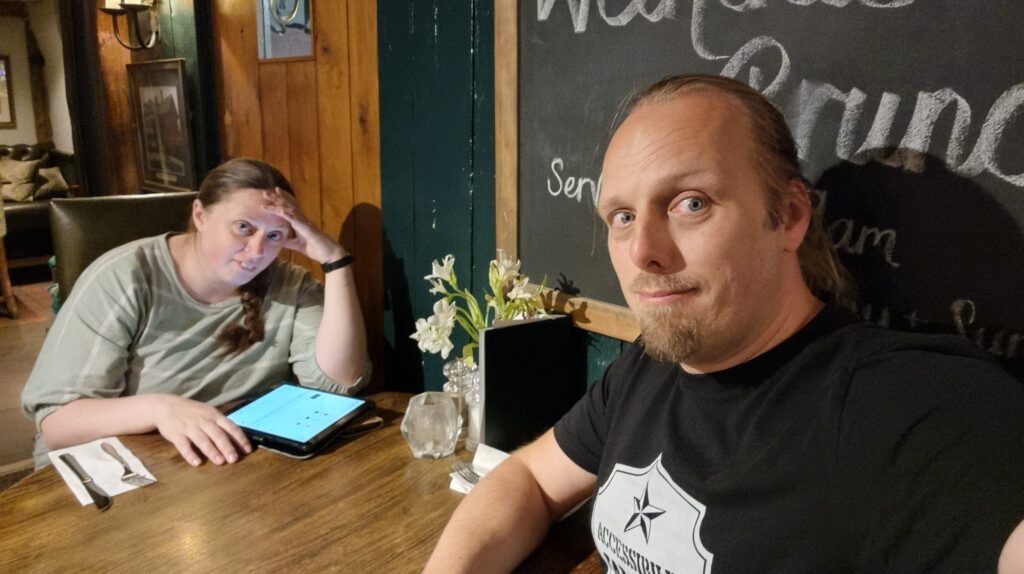
We resolved to try to do the same kinds of things that we’d hoped to do on the Isle of Man, but closer to home: some sightseeing, some walks, some spending-time-together. You know the drill.
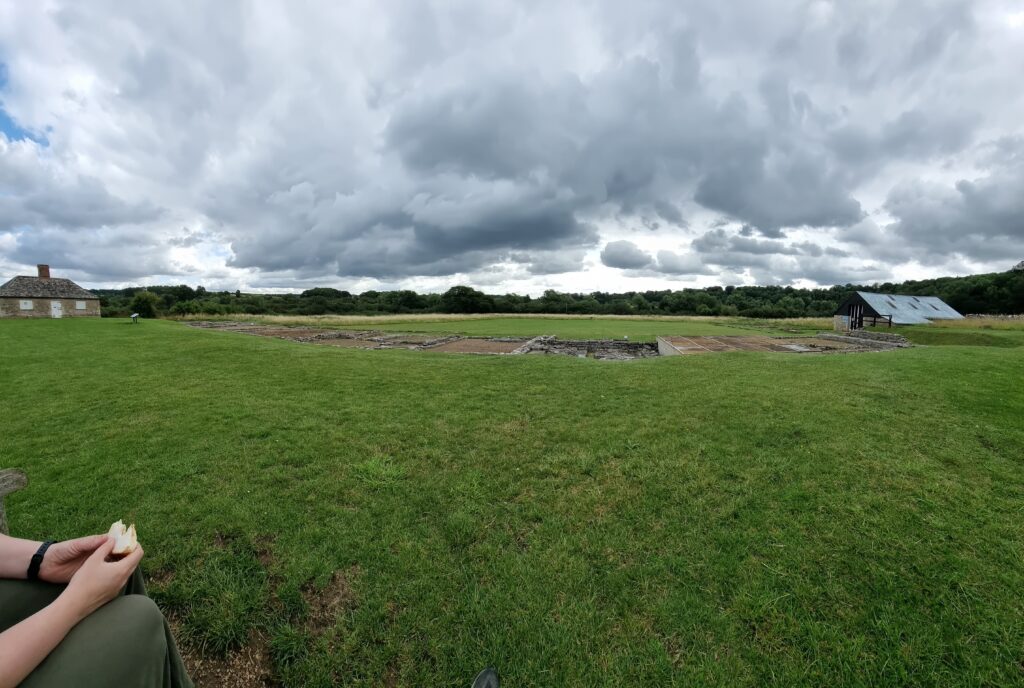
A particular highlight of our trip to the North Leigh Roman Villa – one of those “on your doorstep so you never go” places – was when the audio tour advised us to beware of the snails when crossing what was once the villa’s central courtyard.
At first we thought this was an attempt at humour, but it turns out that the Romans brought with them to parts of Britain a variety of large edible snail – helix pomatia – which can still be found in concentration in parts of the country where they were widely farmed.4
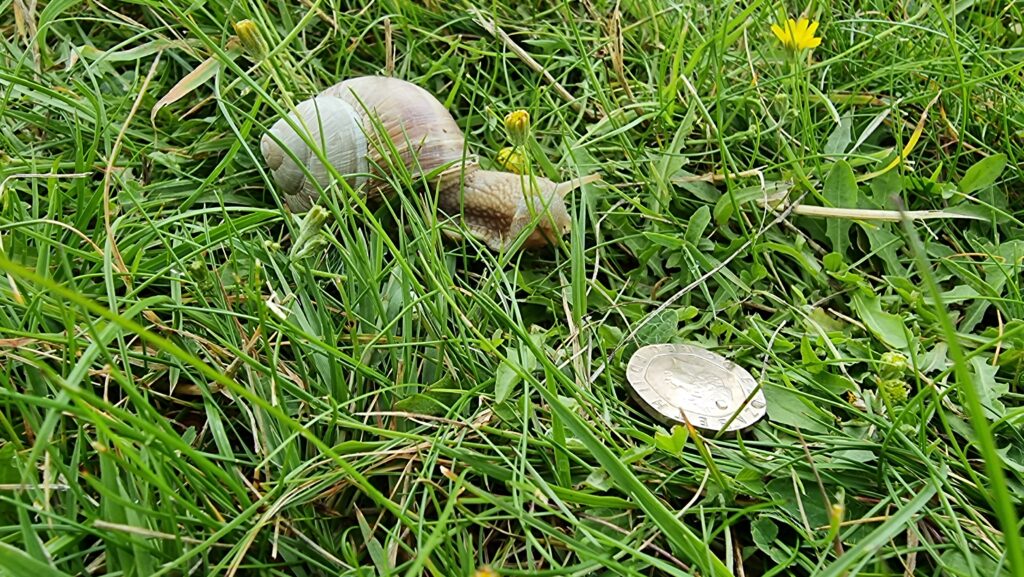
There’s a nice little geocache near the ruin, too, which we were able to find on our way back.
Before you think that I didn’t get anything out of my pointless hours at the airport, though, it turns out I’d brought home a souvenier… a stinking cold! How about that for efficiency: I got all the airport-germs, but none of the actual air travel. By mid-afternoon on Tuesday I was feeling pretty rotten, and it only got worse from then on.

I’m confident that Ruth didn’t mind too much that I spent Wednesday mostly curled up in a sad little ball, because it let her get on with applying to a couple of jobs she’s interested in. Because it turns out there was a third level of disaster to this week: in addition to our ‘plane being cancelled and me getting sick, this week saw Ruth made redundant as her employer sought to dig itself out of a financial hole. A hat trick of bad luck!

As Ruth began to show symptoms (less-awful than mine, thankfully) of whatever plague had befallen me, we bundled up in bed and made not one but two abortive attempts at watching a film together:
- Spin Me Round, which looked likely to be a simple comedy that wouldn’t require much effort by my mucus-filled brain, but turned out to be… I’ve no idea what it was supposed to be. It’s not funny. It’s not dramatic. The characters are, for the most part, profoundly uncompelling. There’s the beginnings of what looks like it was supposed to be a romantic angle but it mostly comes across as a creepy abuse of power. We watched about half and gave up.
- Ant-Man and the Wasp: Quantumania, because we figured “how bad can a trashy MCU sequel be anyway; we know what to expect!” But we couldn’t connect to it at all. Characters behave in completely unrealistic ways and the whole thing feels like it was produced by somebody who wanted to be making one of the new Star Wars films, but with more CGI. We watched about half and gave up.
As Thursday drew on and the pain in my head and throat was replaced with an unrelenting cough, I decided I needed some fresh air.

So while Ruth collected the shopping, I found my way to the 2023-07-27 51 -1 geohashpoint. And came back wheezing and in need of a lie-down.
I find myself wondering if (despite three jabs and a previous infection) I’ve managed to contract covid again, but I haven’t found the inclination to take a test. What would I do differently if I do have it, now, anyway? I feel like we might be past that point in our lives.
All in all, probably the worst anniversary celebration we’ve ever had, and hopefully the worst we’ll ever have. But a fringe benefit of a willingness to change bases is that we can celebrate our 10th5 anniversary next year, too. Here’s to that.
Footnotes
1 Because we’re that kind of nerds, we count our anniversaries in base 16
(0x10 is 16), or – sometimes – in whatever base is mathematically-pleasing and gives us a nice round number. It could be our 20th anniversary, if you prefer octal.
2 I’ve been on some disastrous aeroplane journeys before, including one just earlier this year which was supposed to take me from Athens to Heathrow, got re-arranged to go to Gatwick, got delayed, ran low on fuel, then instead had to fly to Stansted, wait on the tarmac for a couple of hours, then return to Gatwick (from which I travelled – via Heathrow – home). But this attempt to get to the Isle of Man was somehow, perhaps, even worse.
3 Those who’ve noticed that we were flying EasyJet might rightly give a knowing nod at this point.
4 The warning to take care not to tread on them is sound legal advice: this particular variety of snail is protected under the Wildlife and Countryside Act 1981!
5 Next year will be our 10th anniversary… in base 17. Eww, what the hell is base 17 for and why does it both offend and intrigue me so?
Short-Term Blogging
There’s a perception that a blog is a long-lived, ongoing thing. That it lives with and alongside its author.1
But that doesn’t have to be true, and I think a lot of people could benefit from “short-term” blogging. Consider:
-
Photoblogging your holiday, rather than posting snaps to social media
You gain the ability to add context, crosslinking, and have permanent addresses (rather than losing eveything to the depths of a feed). You can crosspost/syndicate to your favourite socials if that’s your poison..

-
Blogging your studies, rather than keeping your notes to yourself
Writing what you learn helps you remember it; writing what you learn in a public space helps others learn too and makes it easy to search for your discoveries later.2 -
Recording your roleplaying, rather than just summarising each session to your fellow players
My D&D group does this at levellers.blog! That site won’t continue to be updated forever – the party will someday retire or, more-likely, come to a glorious but horrific end – but it’ll always live on as a reminder of what we achieved.
One of my favourite examples of such a blog was 52 Reflect3 (now integrated into its successor The Improbable Blog). For 52 consecutive weeks my partner‘s brother Robin blogged about adventures that took him out of his home in London and it was amazing. The project’s finished, but a blog was absolutely the right medium for it because now it’s got a “forever home” on the Web (imagine if he’d posted instead to Twitter, only for that platform to turn into a flaming turd).
I don’t often shill for my employer, but I genuinely believe that the free tier on WordPress.com is an excellent way to give a forever home to your short-term blog4. Did you know that you can type new.blog (or blog.new; both work!) into your browser to start one?
What are you going to write about?
Footnotes
1 This blog is, of course, an example of a long-term blog. It’s been going in some form or another for over half my life, and I don’t see that changing. But it’s not the only kind of blog.
2 Personally, I really love the serendipity of asking a web search engine for the solution to a problem and finding a result that turns out to be something that I myself wrote, long ago!
3 My previous posts about 52 Reflect: Challenge Robin, Twatt, Brixton to Brighton by Boris Bike, Ending on a High (and associated photo/note)
4 One of my favourite features of WordPress.com is the fact that it’s built atop the world’s most-popular blogging software and you can export all your data at any time, so there’s absolutely no lock-in: if you want to migrate to a competitor or even host your own blog, it’s really easy to do so!
Werewolves and Wanderer
This blog post is also available as a video. Would you prefer to watch/listen to me tell you about the video game that had the biggest impact on my life?
Of all of the videogames I’ve ever played, perhaps the one that’s had the biggest impact on my life1 was: Werewolves and (the) Wanderer.2
This simple text-based adventure was originally written by Tim Hartnell for use in his 1983 book Creating Adventure Games on your Computer. At the time, it was common for computing books and magazines to come with printed copies of program source code which you’d need to re-type on your own computer, printing being significantly many orders of magnitude cheaper than computer media.3

I’d been working my way through the operating manual for our microcomputer, trying to understand it all.5
![Scan of a ring-bound page from a technical manual. The page describes the use of the "INPUT" command, saying "This command is used to let the computer know that it is expecting something to be typed in, for example, the answer to a question". The page goes on to provide a code example of a program which requests the user's age and then says "you look younger than [age] years old.", substituting in their age. The page then explains how it was the use of a variable that allowed this transaction to occur.](/_q23u/2023/07/cpc664-manual-input-command.png)
[ENTER] at the end of each line.
In particular, I found myself comparing Werewolves to my first attempt at a text-based adventure. Using what little I’d grokked of programming so far, I’d put together
a series of passages (blocks of PRINT statements6)
with choices (INPUT statements) that sent the player elsewhere in the story (using, of course, the long-considered-harmful GOTO statement), Choose-Your-Own-Adventure style.
Werewolves was… better.

Werewolves and Wanderer was my first lesson in how to structure a program.
Let’s take a look at a couple of segments of code that help illustrate what I mean (here’s the full code, if you’re interested):
10 REM WEREWOLVES AND WANDERER 20 GOSUB 2600:REM INTIALISE 30 GOSUB 160 40 IF RO<>11 THEN 30 50 PEN 1:SOUND 5,100:PRINT:PRINT "YOU'VE DONE IT!!!":GOSUB 3520:SOUND 5,80:PRINT "THAT WAS THE EXIT FROM THE CASTLE!":SOUND 5,200 60 GOSUB 3520 70 PRINT:PRINT "YOU HAVE SUCCEEDED, ";N$;"!":SOUND 5,100 80 PRINT:PRINT "YOU MANAGED TO GET OUT OF THE CASTLE" 90 GOSUB 3520 100 PRINT:PRINT "WELL DONE!" 110 GOSUB 3520:SOUND 5,80 120 PRINT:PRINT "YOUR SCORE IS"; 130 PRINT 3*TALLY+5*STRENGTH+2*WEALTH+FOOD+30*MK:FOR J=1 TO 10:SOUND 5,RND*100+10:NEXT J 140 PRINT:PRINT:PRINT:END ... 2600 REM INTIALISE 2610 MODE 1:BORDER 1:INK 0,1:INK 1,24:INK 2,26:INK 3,18:PAPER 0:PEN 2 2620 RANDOMIZE TIME 2630 WEALTH=75:FOOD=0 2640 STRENGTH=100 2650 TALLY=0 2660 MK=0:REM NO. OF MONSTERS KILLED ... 3510 REM DELAY LOOP 3520 FOR T=1 TO 900:NEXT T 3530 RETURN
...) have been added for readability/your convenience.
What’s interesting about the code above? Well…
- The code for “what to do when you win the game” is very near the top. “Winning” is the default state. The rest of the adventure exists to obstruct that. In a language with enforced line numbering and no screen editor7, it makes sense to put fixed-length code at the top… saving space for the adventure to grow below.
- Two subroutines are called (the
GOSUBstatements):- The first sets up the game state: initialising the screen (
2610), the RNG (2620), and player characteristics (2630–2660). This also makes it easy to call it again (e.g. if the player is given the option to “start over”). This subroutine goes on to set up the adventure map (more on that later). - The second starts on line
160: this is the “main game” logic. After it runs, each time, line40checksIF RO<>11 THEN 30. This tests whether the player’s location (RO) is room 11: if so, they’ve exited the castle and won the adventure. Otherwise, flow returns to line30and the “main game” subroutine happens again. This broken-out loop improving the readability and maintainability of the code.8
- The first sets up the game state: initialising the screen (
- A common subroutine is the “delay loop” (line
3520). It just counts to 900! On a known (slow) processor of fixed speed, this is a simpler way to put a delay in than relying on a real-time clock.
The game setup gets more interesting still when it comes to setting up the adventure map. Here’s how it looks:
2680 REM SET UP CASTLE 2690 DIM A(19,7):CHECKSUM=0 2700 FOR B=1 TO 19 2710 FOR C=1 TO 7 2720 READ A(B,C):CHECKSUM=CHECKSUM+A(B,C) 2730 NEXT C:NEXT B 2740 IF CHECKSUM<>355 THEN PRINT "ERROR IN ROOM DATA":END ... 2840 REM ALLOT TREASURE 2850 FOR J=1 TO 7 2860 M=INT(RND*19)+1 2870 IF M=6 OR M=11 OR A(M,7)<>0 THEN 2860 2880 A(M,7)=INT(RND*100)+100 2890 NEXT J 2910 REM ALLOT MONSTERS 2920 FOR J=1 TO 6 2930 M=INT(RND*18)+1 2940 IF M=6 OR M=11 OR A(M,7)<>0 THEN 2930 2950 A(M,7)=-J 2960 NEXT J 2970 A(4,7)=100+INT(RND*100) 2980 A(16,7)=100+INT(RND*100) ... 3310 DATA 0, 2, 0, 0, 0, 0, 0 3320 DATA 1, 3, 3, 0, 0, 0, 0 3330 DATA 2, 0, 5, 2, 0, 0, 0 3340 DATA 0, 5, 0, 0, 0, 0, 0 3350 DATA 4, 0, 0, 3, 15, 13, 0 3360 DATA 0, 0, 1, 0, 0, 0, 0 3370 DATA 0, 8, 0, 0, 0, 0, 0 3380 DATA 7, 10, 0, 0, 0, 0, 0 3390 DATA 0, 19, 0, 8, 0, 8, 0 3400 DATA 8, 0, 11, 0, 0, 0, 0 3410 DATA 0, 0, 10, 0, 0, 0, 0 3420 DATA 0, 0, 0, 13, 0, 0, 0 3430 DATA 0, 0, 12, 0, 5, 0, 0 3440 DATA 0, 15, 17, 0, 0, 0, 0 3450 DATA 14, 0, 0, 0, 0, 5, 0 3460 DATA 17, 0, 19, 0, 0, 0, 0 3470 DATA 18, 16, 0, 14, 0, 0, 0 3480 DATA 0, 17, 0, 0, 0, 0, 0 3490 DATA 9, 0, 16, 0, 0, 0, 0
DATA statements form a “table”.
What’s this code doing?
- Line
2690defines an array (DIM) with two dimensions9 (19 by 7). This will store room data, an approach that allows code to be shared between all rooms: much cleaner than my first attempt at an adventure with each room having its ownINPUThandler. - The two-level loop on lines
2700through2730populates the room data from theDATAblocks. Nowadays you’d probably put that data in a separate file (probably JSON!). Each “row” represents a room, 1 to 19. Each “column” represents the room you end up at if you travel in a given direction: North, South, East, West, Up, or Down. The seventh column – always zero – represents whether a monster (negative number) or treasure (positive number) is found in that room. This column perhaps needn’t have been included: I imagine it’s a holdover from some previous version in which the locations of some or all of the treasures or monsters were hard-coded. - The loop beginning on line
2850selects seven rooms and adds a random amount of treasure to each. The loop beginning on line2920places each of six monsters (numbered-1through-6) in randomly-selected rooms. In both cases, the start and finish rooms, and any room with a treasure or monster, is ineligible. When my 8-year-old self finally deciphered what was going on I was awestruck at this simple approach to making the game dynamic. - Rooms 4 and 16 always receive treasure (lines
2970–2980), replacing any treasure or monster already there: the Private Meeting Room (always worth a diversion!) and the Treasury, respectively. - Curiously, room 9 (the lift) defines three exits, even though it’s impossible to take an action in this location: the player teleports to room 10 on arrival! Again, I assume this is vestigal code from an earlier implementation.
- The “checksum” that’s tested on line
2740is cute, and a younger me appreciated deciphering it. I’m not convinced it’s necessary (it sums all of the values in theDATAstatements and expects355to limit tampering) though, or even useful: it certainly makes it harder to modify the rooms, which may undermine the code’s value as a teaching aid!

Something you might notice is missing is the room descriptions. Arrays in this language are strictly typed: this array can only contain integers and not strings. But there are other reasons: line length limitations would have required trimming some of the longer descriptions. Also, many rooms have dynamic content, usually based on random numbers, which would be challenging to implement in this way.
As a child, I did once try to refactor the code so that an eighth column of data specified the line number to which control should pass to display the room description. That’s
a bit of a no-no from a “mixing data and logic” perspective, but a cool example of metaprogramming before I even knew it! This didn’t work, though: it turns out you can’t pass a
variable to a Locomotive BASIC GOTO or GOSUB. Boo!10

Werewolves and Wanderer has many faults11. But I’m clearly not the only developer whose early skills were honed and improved by this game, or who hold a special place in their heart for it. Just while writing this post, I discovered:
- A moderately-faithful Inform reimplementation
- A less-faithful semi-graphical adaptation
- A C# reimplementation with a web interface (video)
- An ongoing livestreamed effort to reimplement as a Sierra-style point-and-click adventure
- An Applesoft BASIC implementation which includes a dynamically-revealed map
- A C reimplementation with a high score table
- A somewhat-faithful reimplementation in Rust (playable online via WebAssembly)
- A very accurate rendition in Python
- A Ruby/Python microservices-based implementation
- Many, many people commenting on the above or elsewhere about how instrumental the game was in their programming journey, too.
A decade or so later, I’d be taking my first steps as a professional software engineer. A couple more decades later, I’m still doing it.
And perhaps that adventure -the one that’s occupied my entire adult life – was facilitated by this text-based one from the 1980s.
Footnotes
1 The game that had the biggest impact on my life, it might surprise you to hear, is not among the “top ten videogames that stole my life” that I wrote about almost exactly 16 years ago nor the follow-up list I published in its incomplete form three years later. Turns out that time and impact are not interchangable. Who knew?
2 The game is variously known as Werewolves and Wanderer, Werewolves and
Wanderers, or Werewolves and the
Wanderer. Or, on any system I’ve been on, WERE.BAS, WEREWOLF.BAS, or WEREWOLV.BAS, thanks to the CPC’s eight-point-three filename limit.
3 Additionally, it was thought that having to undertake the (painstakingly tiresome) process of manually re-entering the source code for a program might help teach you a little about the code and how it worked, although this depended very much on how readable the code and its comments were. Tragically, the more comprehensible some code is, the more long-winded the re-entry process.
4 The CPC’s got a fascinating history in its own right, but you can read that any time.
5 One of my favourite features of home microcomputers was that seconds after you turned them on, you could start programming. Your prompt was an interface to a programming language. That magic had begun to fade by the time DOS came to dominate (sure, you can program using batch files, but they’re neither as elegant nor sophisticated as any BASIC dialect) and was completely lost by the era of booting directly into graphical operating systems. One of my favourite features about the Web is that it gives you some of that magic back again: thanks to the debugger in a modern browser, you can “tinker” with other people’s code once more, right from the same tool you load up every time. (Unfortunately, mobile devices – which have fast become the dominant way for people to use the Internet – have reversed this trend again. Try to View Source on your mobile – if you don’t already know how, it’s not an easy job!)
6 In particular, one frustration I remember from my first text-based adventure was that I’d been unable to work around Locomotive BASIC’s lack of string escape sequences – not that I yet knew what such a thing would be called – in order to put quote marks inside a quoted string!
7 “Screen editors” is what we initially called what you’d nowadays call a “text editor”: an application that lets you see a page of text at the same time, move your cursor about the place, and insert text wherever you feel like. It may also provide features like copy/paste and optional overtyping. Screen editors require more resources (and aren’t suitable for use on a teleprinter) compared to line editors, which preceeded them. Line editors only let you view and edit a single line at a time, which is how most of my first 6 years of programming was done.
8 In a modern programming language, you might use while true or similar for a
main game loop, but this requires pushing the “outside” position to the stack… and early BASIC dialects often had strict (and small, by modern standards) limits on stack height that
would have made this a risk compared to simply calling a subroutine from one line and then jumping back to that line on the next.
9 A neat feature of Locomotive BASIC over many contemporary and older BASIC dialects was its support for multidimensional arrays. A common feature in modern programming languages, this language feature used to be pretty rare, and programmers had to do bits of division and modulus arithmetic to work around the limitation… which, I can promise you, becomes painful the first time you have to deal with an array of three or more dimensions!
10 In reality, this was rather unnecessary, because the ON x GOSUB command
can – and does, in this program – accept multiple jump points and selects the one
referenced by the variable x.
11 Aside from those mentioned already, other clear faults include: impenetrable controls unless you’ve been given instuctions (although that was the way at the time); the shopkeeper will penalise you for trying to spend money you don’t have, except on food, presumably as a result of programmer laziness; you can lose your flaming torch, but you can’t buy spares in advance (you can pay for more, and you lose the money, but you don’t get a spare); some of the line spacing is sometimes a little wonky; combat’s a bit of a drag; lack of feedback to acknowledge the command you enterted and that it was successful; WHAT’S WITH ALL THE CAPITALS; some rooms don’t adequately describe their exits; the map is a bit linear; etc.
Mastodon Re-Introduction
Finally got around to rewriting my Mastodon introduction, now that my selfhosted server’s got enough interconnection that people might actually see it!
If you’re on the Fediverse and you’re not already doing so, you can follow me at @dan@danq.me. Or follow my blog at @blog@danq.me.
Local Expert
At school, our 9-year-old is currently studying the hsitory of human civilization from the late stone age through to the bronze age. The other week, the class was split into three groups, each of which was tasked with researching a different piece of megalithic architecture:
- One group researched Stonehenge, because it’s a pretty obvious iconic choice
- Another group researched the nearby Rollright Stones, which we’ve made a family tradition of visiting on New Year’s Day and have dragged other people along to sometimes
- The final group took the least-famous monument, our very own local village henge The Devil’s Quoits

And so it was that one of our eldest’s classmates was searching on the Web for information about The Devil’s Quoits when they found… my vlog on the subject! One of them recognised me and said, “Hey, isn’t that your Uncle Dan?”1
On the school run later in the day, the teacher grabbed me and asked if I’d be willing to join their school trip to the henge, seeing as I was a “local expert”. Naturally, I said yes, went along, and told a bunch of kids what I knew!
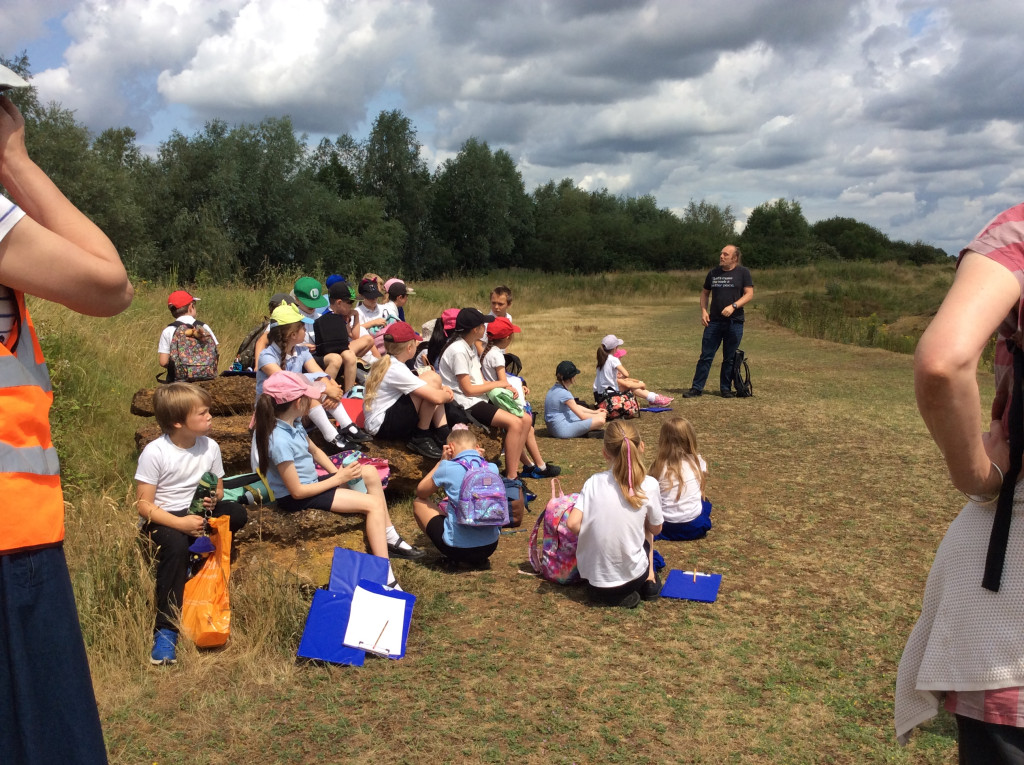
I was slightly intimidated because the class teacher, Miss Hutchins, is really good! Coupled with the fact that I don’t feel like a “local expert”2, this became a kick-off topic for my most-recent coaching session (I’ve mentioned how awesome my coach is before).
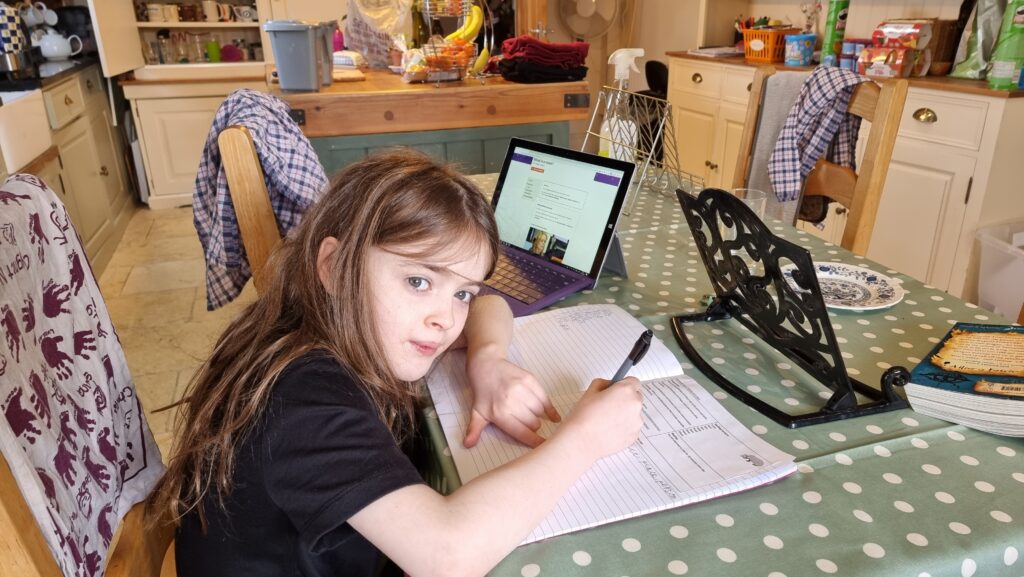
I eventually talked to the class mostly about the human geography aspects of the site’s story. The area around the Devil’s Quoits has changed so much over the millenia, and it’s a fascinating storied history in which it’s been:
- A prehistoric henge and a circle of 28 to 36 stones (plus at least one wooden building, at some point).
- Medieval farms, from which most of the stones were taken (or broken up) and repurposed.
- A brief (and, it turns out, incomplete) archeological survey on the remains of the henge and the handful of stones still-present.
- A second world war airfield (a history I’ve also commemorated with a geocache).
- Quarrying operations leaving a series of hollowed-out gravel pits.
- More-thorough archeological excavation, backed by an understanding of the cropmarks visible from aircraft that indicate that many prehistoric people lived around this area.
- Landfill use, filling in the former gravel pits (except for one, which is now a large lake).
- Reconstruction of the site to a henge and stone circle again.3

It turns out that to be a good enough to pass as a “local expert”, you merely have to know enough. Enough to be able to uplift and inspire others, and the humility to know when to say “I don’t know”.4
That’s a lesson I should take to heart. I (too) often step back from the opportunity to help others learn something new because I don’t feel like I’m that experienced at whatever the subject is myself. But even if you’re still learning something, you can share what you’ve learned so far and help those behind you to follow the same path. I’m forever learning new things, and I should try to be more-open to sharing “as I learn”. And to admit where I’ve still got a long way to go.
Footnotes
1 Of course, I only made the vlog because I was doing a videography course at the time and needed subject matter, and I’d recently been reading a lot about the Quoits because I was planning on “hiding” a virtual geocache at the site, and then I got carried away. Self-nerdsniped again!
2 What is a local expert? I don’t know, but what I feel like is just a guy who read a couple of books because he got distracted while hiding a geocache!
3 I’ve no idea what future archeologists will make of this place when they finda reconstructed stone circle and then, when they dig nearby, an enormous quantity of non-biodegradable waste. What was this strange stone circle for, they’ll ask themselves? Was it a shrine to their potato-based gods, to whom they left crisp packets as a sacrifice?
4 When we’re talking about people from the neolithic, saying “I don’t know” is pretty easy, because what we don’t know is quite a lot, it turns out!
Making a Home of Each Other (The Eggs)
This article is a repost promoting content originally published elsewhere. See more things Dan's reposted.
I dislike recipe posts that, before you get anywhere near the list of ingredients, tell you what feels like the entire life story of the author and their family.
“Every morning my mother would warm up the stove, and this was a wood-fired stove back in the day, and make these. We lived in Minnosota…” I don’t care. I can’t begin to tell you how much I don’t care. Just tell me how to make the damn muffins ‘cos the picture’s got me drooling.
This is different. This is the latest and so-far only exception. This, I care about:
When we moved into a house of our own, I bought us a tea kettle that whistled in harmony when it boiled. Rent was cheap, and we were happy. Those were the days of sweet potato hash, wilted kale, and increasingly exotic baked goods. There was the Me-Making-You-Tea-in-the-Morning-Because-You-Hated-Mornings Phase, but also the You-Making-Me-Tea-in-the-Morning-Because-You-Went-to-Work-at-5am Phase.
…
Lucy tells a story so rich and personal about her and her wife’s experience of life, cohabitation, food, and the beauty of everyday life. I haven’t even read the recipe for The Eggs, even though it sounds pretty delicious.
…
Over the years I’ve found words for people who have done what we’re doing now, but I’ve also found a deeper truth: our queer community doesn’t demand a definition. They know that chili oil can change a life just as much as a marriage. That love is in the making and unmaking of beds. The candlelit baths. The laughter. The proffered feast that nourishes.
Queerness makes room within it for these relationships, or rather: queerness spirals outward. It blooms and embraces. That is the process by which we broaden our palates, welcoming what might seem new to us, but which is actually older than we know.
…
It’s a great reminder about focussing on what’s important. About the value of an ally whether the world’s working with you or against you. And, of course, about how every relationship, no matter what shape, size, or form, can enjoy a little more queering once in a while. Go read it.
Have Fun with Missions, Visions, and Values
I just spent a lightweight week in Rome with fellow members of Automattic‘s Team Fire.
Among our goals for the week was an attempt to strengthen the definition of who are team are, what we work on, and how and why we do so. That’s basically a team-level identity, mission, vision, and values, right?

Fellow Automattician Ben Dwyer recently wrote about his experience of using a deck of Dixit cards to help his team refine their values in a fun and engaging way. I own a Dixit set, so we decided to give it a go too.

Normally when you play Dixit, you select a card from your hand – each shows a unique piece of artwork – and try to describe it in a way that’s precise enough that some of the other players will later be able to pick it out of a line-up, but ambiguous enough that not all the other players will. It’s a delicate balancing act. Even when our old Geek Night was in full swing we didn’t used to play it often because our well-established group’s cornucopia of in-jokes and references made it trivially easy to “target” your descriptions at specific players1, but it’s still a solid icebreaker activity.

Perhaps it was the fantasy artwork that inspired us or maybe it just says something about how my team sees themselves, but what we came up with had a certain… swords-and-sorcery… even Dungeons & Dragons… feel to it.

Ou team’s new identity isn’t finalised, but I love the fact that we’ve been able to inject a bit of fun and whimsy into it. At our last draft, my team looks to be defined as comprising:
- Gareth, level 62 Pathfinder, leading the way through the wilds
- Bero, Level 5 Battlesmith, currently lost in the void
- Dan (me!), Level 5 Arcane Trickster, breaking locks and stealing treasure
- Cem, Level 4 Dragonslayer, smashing doors and bugs alike
- Lae, Level 7 Pirate, seabound rogue with eyes on the horizon
- Kyle, Level 5 Apprentice Bard, master of words and magic
- Simran, Level 6 Apprentice Code Witch, weaving spells from nature
I think that’s pretty awesome.
Travelling light
Now that travel for work is back on the menu, I’ve been trying to upgrade my “pack light” game.
I’ve been inspired in part by Beau, who I first met during my trip to South Africa in 2019 during my Automattic onboarding. Beau travelled from the US for a two week jaunt with nothing but hand luggage, and it blew my mind.
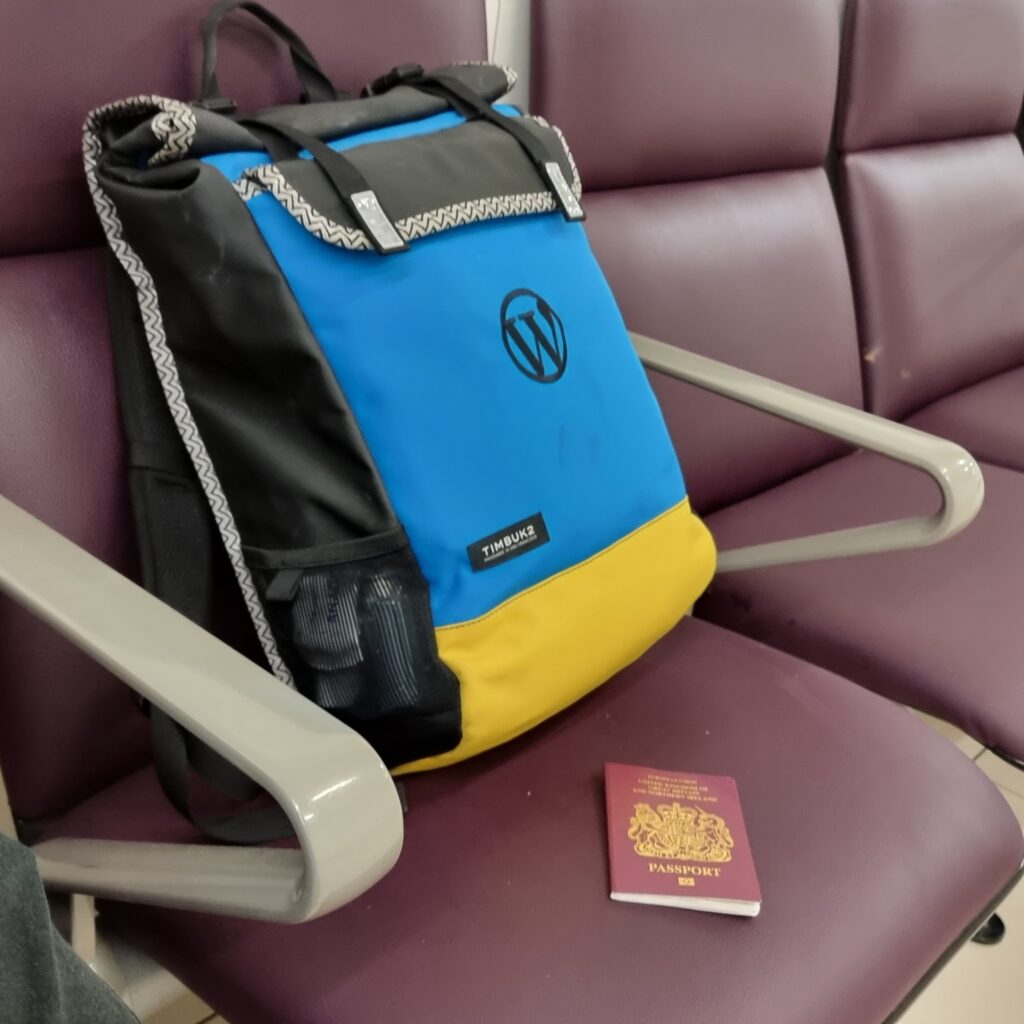
For my trip to Vienna earlier this year for a divisional meetup, I got by with just a backpack and a laptop bag. Right now, I’m waiting to fly to Rome for a week, and I’ve ditched the laptop bag in favour of just a single carry-on backpack. About 7kg of luggage, and well within the overhead locker size limit.
I’m absolutely sold on this approach. I get to:
- walk past the queues for luggage drop (having checked-in online),
- keep the entirety of my luggage with me at all times (which ensures it goes where I do),
- breeze through security1, thanks to smart packing2
- walk right out of the airport at the other end without having to wait for the flingers to finish smashing everybody’s luggage into the carousels.

As somebody who’s travelled “heavy” for most of my life – and especially since the children came along – it’s liberating to migrate to a “pick up a bag and go” mindset. To begin with, the nagging thought that I must’ve forgotten something essential was challenging, but I think I’ve gotten past that stage now.
Travelling light feels like carefree: like being a kid again, when all you needed was the back on your back and you were ready for an adventure. Once again, I’ve got a bag on my back3 and I know that everything I need for an adventure is right here with me4.
Footnotes
1 If you’ve travelled with me before, you might have noticed that I sometimes have trouble at borders on account of my damn stupid name, as predicted by the Passport Office. I’ve since learned all the requisite tricks to sidestep these problems, but that’s probably worthy of a post in its own right.
2 A little smart packing goes a long way. In the photo above, you might see my pre-prepared liquids bag in a side pocket, my laptop slides right out for separate scanning, my wallet and phone just dump out of my pockets, and I’m done.
3 I don’t really have a bag on my back right now. I’m sat in a depature lounge at Gatwick Airport. But you get the idea.
4 Do I really have everything I need? I’ve not brought a waterproof coat and, looking at the weather forecast at my destination, this might have been a mistake. But worst case I can buy a cheap poncho at the other end. That’s the kind of freedom that being an adult gets you, replacing the childlike freedom to get soaked and not care.
Normal for Children
Lacking a basis for comparison, children accept their particular upbringing as normal and representative.

Kit was telling me about how his daughter considers it absolutely normal to live in a house full of insectivorous plants1, and it got me thinking about our kids, and then about myself:
I remember once overhearing our eldest, then at nursery, talking to her friend. Our kid had mentioned doing something with her “mummy, daddy, and Uncle Dan” and was incredulous that her friend didn’t have an Uncle Dan that they lived with! Isn’t having three parents… just what a family looks like?

By the time she was at primary school, she’d learned that her family wasn’t the same shape as most other families, and she could code-switch with incredible ease. While picking her up from school, I overheard her talking to a friend about a fair that was coming to town. She told the friend that she’d “ask her dad if she could go”, then turned to me and said “Uncle Dan: can we go to the fair?”; when I replied in the affirmitive, she turned back and said “my dad says it’s okay”. By the age of 5 she was perfectly capable of translating on-the-fly2 in order to simultaneously carry out intelligble conversations with her family and with her friends. Magical.
When I started driving, and in particular my first few times on multi-lane carriageways, something felt “off” and it took me a little while to work out what it was. It turns out that I’d internalised a particular part of the motorway journey experience from years of riding in cars driven by my father, who was an unrepentant3 and perpetual breaker of speed limits.4 I’d come to associate motorway driving with overtaking others, but almost never being overtaken, but that wasn’t what I saw when I drove for myself.5 It took a little thinking before I realised the cause of this false picture of “what driving looks like”.

The thing is: you only ever notice the “this is normal” definitions that you’ve internalised… when they’re challenged!
It follows that there are things you learned from the quirks of your upbringing that you still think of as normal. There might even be things you’ll never un-learn. And you’ll never know how many false-normals you still carry around with you, or whether you’ve ever found them all, exept to say that you probably haven’t yet.

It’s amazing and weird to think that there might be objective truths you’re perpetually unable to see as a restult of how, or where, or by whom you were brought up, or by what your school or community was like, or by the things you’ve witnessed or experienced over your life. I guess that all we can all do is keep questioning everything, and work to help the next generation see what’s unusual and uncommon in their own lives.
Footnotes
1 It’s a whole thing. If you know Kit, you’re probably completely unsurprised, but spare a thought for the poor randoms who sometimes turn up and read my blog.
2 Fully billingual children who typically speak a different language at home than they do at school do this too, and it’s even-more amazing to watch.
3 I can’t recall whether his license was confiscated on two or three separate ocassions, in the end, but it was definitely more than one. Having a six month period where you and your siblings have to help collect the weekly shop from the supermarket by loading up your bikes with shopping bags is a totally normal part of everybody’s upbringing, isn’t it?
4 Virtually all of my experience as a car passenger other than with my dad was in Wales, where narrow windy roads mean that once you get stuck behind something, that’s how you’re going to be spending your day.
5 Unlike my father, I virtually never break the speed limit, to such an extent that when I got a speeding ticket the other year (I’d gone from a 70 into a 50 zone and re-set the speed limiter accordingly, but didn’t bother to apply the brakes and just coasted down to the new speed… when the police snapped their photo!), Ruth and JTA both independently reacted to the news with great skepticism.
Nightmares & Noggins
Last night I had a nightmare about Dungeons & Dragons. Specifically, about the group I DM for on alternate Fridays.
In their last session the party – somewhat uncharacteristically – latched onto a new primary plot hook rightaway. Instead of rushing off onto some random side quest threw themselves directly into this new mission.

This effectively kicked off a new chapter of their story, so I’ve been doing some prep-work this last week or so. Y’know: making battlemaps, stocking treasure chests with mysterious and powerful magical artefacts, and inventing a plethora of characters for the party to either befriend or kill (or, knowing this party: both).
Anyway: in the dream, I sat down to complete the prep-work I want to get done before this week’s play session. I re-checked my notes about what the adventurers had gotten up to last time around, and… panicked! I was wrong, they hadn’t thrown themselves off the side of a city floating above the first layer of Hell at all! I’d mis-remembered completely and they’d actually just ventured into a haunted dungeon. I’d been preparing all the wrong things and now there wasn’t time to correct my mistakes!

This is, of course, an example of the “didn’t prepare for the test” trope of dreams. Clearly I’m still feeling underprepared for this week’s game! But probably a bigger reason for the dream, and remembering it, was that I’ve had a cold and kept waking up to cough.
Right, better do a little more prep work!
AI is lying to you
I’ve resisted writing about the current trends in AI because, well, others are already doing it better.1 But I was inspired by Garrett‘s observation that – according to the Washington Post – the C4 dataset has tokenised his personal website.

-v (verbose mode) activated.
Much has been said about how ChatGPT and her friends will hallucinate and mislead. Let’s take an example.
Remember that ChatGPT has almost-certainly read basically everything I’ve ever written online – it might well be better-informed about me better than you are – as you read this:

When I asked ChatGPT about me, it came up with a mixture of truths and believable lies2, along with a smattering of complete bollocks.
In another example, ChatGPT hallucinates this extra detail specifically because the conversation was foreshadowed by its previous mistake. At this point, it digs its heels in and commits to its claim, like the stubborn guy in the corner of the pub who doubles-down on his bullshit.
If you were to ask at the outset who wrote Notpron, ChatGPT would have gotten it right, but because it already mis-spoke, it’s now trapped itself in a lie, incapable of reconsidering what it said previously as having been anything but the truth:

Simon Willison says that we should call this behaviour “lying”. In response to this, several people told him that the “lying” excessively anthropomorphises these chatbots, implying that they’re deliberately attempting to mislead their users. Simon retorts:
I completely agree that anthropomorphism is bad: these models are fancy matrix arithmetic, not entities with intent and opinions.
But in this case, I think the visceral clarity of being able to say “ChatGPT will lie to you” is a worthwhile trade.
I agree with Simon. ChatGPT and systems like it are putting accessible AI into the hands of the masses, and that means that the people who are using it don’t necessarily understand – nor desire to learn – the statistical mechanisms that actually underpin the AI‘s “decisions” about how to respond.
Trying to explain how and why their new toy will get things horribly wrong is hard, and it takes a critical eye, time, and practice to begin to discover how to use these tools effectively and safely.3 It’s simpler just to say “Here’s a tool; by the way, it’s a really convincing liar and you can’t trust it even a little.”
Giving people tools that will lie to them. What an interesting time to be alive!
Footnotes
1 I’m tempted to blog about my experience of using Stable Diffusion and GPT-3 as assistants while DMing my regular Dungeons & Dragons game, but haven’t worked out exactly what I’m saying yet.
2 That ChatGPT lies won’t be a surprise to anybody who’s used the system nor anybody who
understands the fundamentals of how it works, but as AIs get integrated into more and more things, we’re going to need to teach a level of technical literacy about what that means,
just like we do should about, say, Wikipedia.
3 For many of the tasks people talk about outsourcing to LLMs, it’s the case that it would take less effort for a human to learn how to do the task that it would for them to learn how to supervise an AI performing the task! That’s not to say they’re useless: just that (for now at least) you should only trust them to do something that you could do yourself and you’re therefore able to critically assess how well the machine did it.
Dan Q found GC5F425 Lovers Walk
This checkin to
GC5F425 Lovers Walk
reflects
a geocaching.com log entry. See
more of Dan's cache logs.
My GPSr dropped me next to a far older bit of architecture than the one that hosts the cache, but found after a short search. I’m staying nearby as part of a charity hackathon for a nonprofit I’m involved with, but came out for a walk and an explore while between other tasks. SL, TFTC.
New Far Side in FreshRSS
I got some great feedback to yesterday’s post about using FreshRSS + XPath to subscribe to Forward, including helpful comments from FreshRSS developer Alexandre Alapetite and from somebody who appreciated it and my Far Side “Daily Dose” recipe and wondered if it was possible to get the new Far Side content in FreshRSS too.
Wait, there’s new Far Side content? Yup: it turns out Gary Larson’s dusted off his pen and started drawing again. That’s awesome! But the last thing I want is to have to go to the website once every few… what: days? weeks? months? He’s not syndicated any more so he’s not got a deadline to work to! If only there were some way to have my feed reader, y’know, do it for me and let me know whenever he draws something new.

Here’s my setup for getting Larson’s new funnies right where I want them:
-
Feed URL:
https://www.thefarside.com/new-stuff/1
This isn’t a valid address for any of the new stuff, but always seems to redirect to somewhere that is, so that’s nice. -
XPath for finding news items:
//div[@class="swiper-slide"]
Turns out all the “recent” new stuff gets loaded in the HTML and then JavaScript turns it into a slider etc.; some of the CSS classes change when the JavaScript runs so I needed to View Source rather than use my browser’s inspector to find everything. -
Item title:
concat("Far Side #", descendant::button[@aria-label="Share"]/@data-shareable-item)
Ugh. The easiest place I could find a “clean” comic ID number was in adata-attribute of the “share” button, where it’s presumably used for engagement tracking. Still, whatever works right? -
Item content:
descendant::figcaption
When Larson captions a comic, the caption is important. -
Item link (URL) and item unique ID:
concat("https://www.thefarside.com", ./@data-path)
The URLs work as direct links to the content, and because they’re unique, they make a reasonable unique ID too (so long as their numbering scheme is internally-consistent, this should stop a re-run of new content popping up in your feed reader if the same comic comes around again). -
Item thumbnail:
concat("https://fox.q-t-a.uk/referer-faker.php?pw=YOUR-SECRET-PASSWORD-GOES-HERE&referer=https://www.thefarside.com/&url=", descendant::img[@data-src]/@data-src)
The Far Side usesReferer:headers as an anti-hotlinking measure, which prevents us easily loading the images directly in an RSS reader. I use this tiny PHP script as a proxy to mitigate that. If you don’t have such a proxy set up, you could simply omit the “Item thumbnail” and “Item content” fields and click the link to go to the original page. -
Item date:
normalize-space(descendant::div[@class="tfs-comic-new__meta"]/*[1])
The date is spread through two separate text nodes, so we get the content of their wrapper and usenormalize-spaceto tidy the whitespace up. The date format then looks like “Wednesday, March 29, 2023”, which we can parse using a custom date/time format string: -
Custom date/time format:
l, F j, Y
I promise I’ll stop writing about how awesome FreshRSS + XPath is someday. Today isn’t that day.
Meanwhile: if you used to use a feed reader but gave up when the Web started to become hostile to them and big social media systems started to wall you in, you should really consider picking one up again. The stuff I write about is complex edge-cases that most folks don’t need to think about in order to benefit from RSS… but it’s super convenient to have the things you care about online (news, blogs, social media, videos, newsletters, comics, search trends…) collated and sorted for you… without interference from algorithms that want to push “sticky” content, without invasive tracking or advertisements (or cookie banners or privacy popups), without something “disappearing” simply because you put off reading it for a few days.